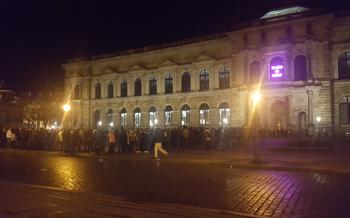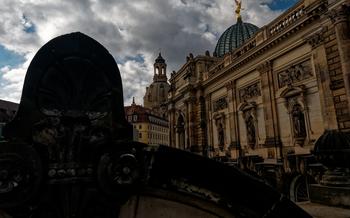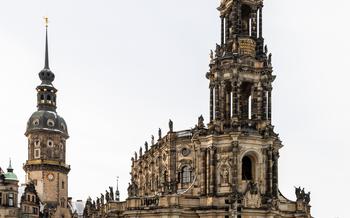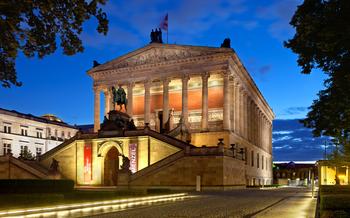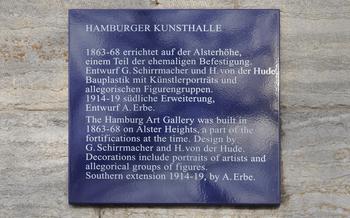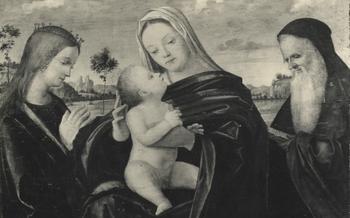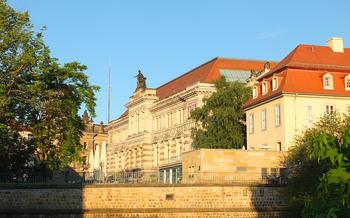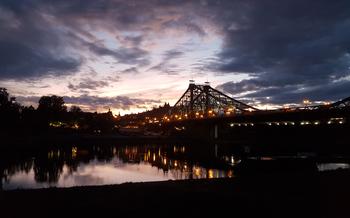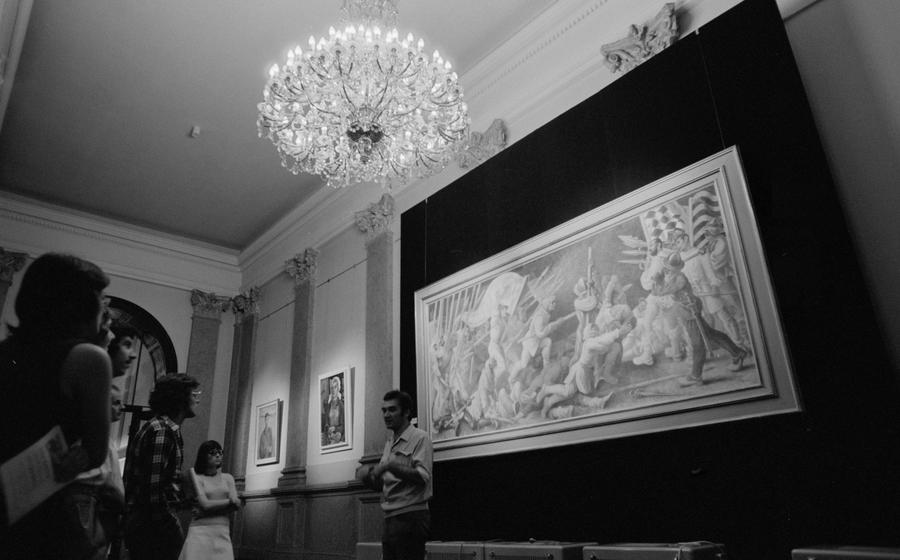
The New Masters Gallery (Galerie Neue Meister)
- The New Masters Gallery (Galerie Neue Meister): A Brief Overview
- Masterpieces of German Romanticism: Exploring the Art Movement
- Key Characteristics of German Romanticism in Art
- Notable Romantic Artists and Their Works in the Gallery
- Symbolism and Allegorical Elements in the Paintings
- Influence of Nature and the Supernatural on the Art
- Caspar David Friedrich: A Romantic Icon
- Carl Gustav Carus: Nature's Mystic
- The Dresden School: A Collaborative Legacy
- Other Notable Artists: Expanding the Narrative
- Temporary Exhibitions: A Dynamic Showcase
- Educational Programs: Engaging with Art
- The Gemäldegalerie Alte Meister: A Companion Gallery
- Photography and Social Media: Capturing the Experience
- Shopping and Souvenirs: Mementos of Your Visit
- Food and Drink Options: Refueling and Refreshing
- Nearby Attractions: Exploring Dresden's Treasures
- Insider Tip: Uncrowded Hours for a Tranquil Experience
The New Masters Gallery (Galerie Neue Meister): A Brief Overview
In the heart of Dresden, Germany, lies an artistic treasure trove known as the New Masters Gallery (Galerie Neue Meister). This magnificent institution is a testament to the rich artistic legacy of Germany, particularly the Romantic movement of the 19th century. Housed within a stunning neoclassical building, the gallery showcases an impressive collection of paintings, sculptures, and drawings, taking visitors on a journey through the evolution of German art.
The gallery's historical significance is intertwined with the development of the Dresden Academy of Fine Arts, one of Europe's oldest and most renowned art schools. Founded in 1764, the academy played a pivotal role in shaping the artistic landscape of Germany, attracting talented artists from across the country. Many of these artists, including Caspar David Friedrich and Carl Gustav Carus, became prominent figures in the Romantic movement, leaving an indelible mark on the gallery's collection.
The architectural features of the New Masters Gallery are as captivating as the artworks it houses. The building itself, constructed between 1847 and 1855, is a masterpiece of neoclassicism, characterized by its grand façade, elegant columns, and intricate ornamentation. The gallery's spacious interior features high ceilings, natural light flooding in from large windows, and carefully designed exhibition spaces that complement the artworks.
Masterpieces of German Romanticism: Exploring the Art Movement
Key Characteristics of German Romanticism in Art
German Romanticism, a significant artistic movement that emerged in the late 18th and early 19th centuries, found its expression in the evocative paintings of the Galerie Neue Meister. This movement emphasized the power of imagination, emotion, and intuition, often drawing inspiration from nature, mythology, and the supernatural. Romantic artists sought to capture the inner essence and spiritual significance of the world, rather than merely depicting its outward appearance.
Notable Romantic Artists and Their Works in the Gallery
Among the celebrated Romantic artists represented in the gallery is Caspar David Friedrich, whose iconic landscapes exude a sense of awe and contemplation. His works, such as "The Wanderer above the Sea of Fog" and "Moonrise over the Sea," epitomize the Romantic fascination with the sublime and the infinite. Carl Gustav Carus's paintings, merging art and science, explore the interconnectedness of nature and the human psyche. His works, including "View from the Fichtelgebirge" and "The Four Elements," showcase his unique blend of artistic and scientific sensibilities.
Symbolism and Allegorical Elements in the Paintings
Romantic paintings often employed symbolism and allegorical elements to convey deeper meanings and emotions. Friedrich's "The Cross in the Mountains" is a powerful symbol of faith and hope, while Carus's "The Four Temperaments" allegorically represents the different personality traits associated with the classical elements. These symbolic elements invite viewers to contemplate the underlying themes and messages embedded within the artworks.
Influence of Nature and the Supernatural on the Art
Nature played a central role in Romantic art, seen as a source of divine inspiration and a reflection of the human soul. Romantic artists sought to capture the emotional resonance of natural phenomena, such as the changing seasons, the grandeur of mountains, and the vastness of the sea. The supernatural and the mystical also found their way into Romantic paintings, often depicted through fantastical creatures, mythological scenes, and dreamlike imagery.
Caspar David Friedrich: A Romantic Icon
Caspar David Friedrich, a towering figure in the Romantic movement, left an indelible mark on the art world with his poignant and symbolic landscapes. Born in Greifswald, Germany, in 1774, Friedrich developed a profound connection with nature from an early age, which would later become a defining characteristic of his art.
Among the masterpieces by Friedrich showcased in the New Masters Gallery is his iconic painting "Wanderer above the Sea of Fog" (1818). This enigmatic work captures a lone figure silhouetted against a vast expanse of fog and mountain peaks, symbolizing the Romantic yearning for the sublime and the infinite. The painting's atmospheric quality and symbolic imagery have made it one of the most recognizable works of the Romantic era.
Another notable work by Friedrich is "The Chalk Cliffs on Rügen" (1818), which depicts towering white cliffs rising majestically from the sea. The painting's stark composition and emphasis on the power and grandeur of nature convey a sense of awe and wonder. Friedrich's distinctive use of light and shadow creates a dramatic and atmospheric effect, enhancing the painting's emotional impact.
Friedrich's landscapes often feature solitary figures contemplating the vastness and mystery of the natural world. These figures represent the Romantic ideal of the individual seeking spiritual fulfillment and transcendence through communion with nature. His works explore themes of mortality, the sublime, and the relationship between humanity and the cosmos.
Through his evocative and symbolic paintings, Caspar David Friedrich emerged as a leading figure of German Romanticism, capturing the essence of the movement's fascination with nature, emotion, and the search for the infinite. His works continue to inspire and captivate viewers, solidifying his legacy as a master of the Romantic era.
Carl Gustav Carus: Nature's Mystic
Physician, naturalist, and artist, Carl Gustav Carus was a multifaceted figure whose unique style blended scientific precision with Romantic sensibilities. Born in Leipzig in 1789, Carus studied medicine and natural sciences before turning his attention to art. His artistic journey took him to Dresden, where he became a prominent member of the Dresden School of painting.
Carus's artworks often depicted landscapes and natural scenes, reflecting his deep connection with the natural world. He employed a distinctive style that combined meticulous observation with a poetic and symbolic approach. His paintings were characterized by a harmonious fusion of scientific accuracy and emotional expression.
Among Carus's notable works showcased in the New Masters Gallery is "View from the Lilienstein towards the Bastei." This breathtaking landscape captures the grandeur of the Elbe Sandstone Mountains, rendered with remarkable detail and precision. The painting exudes a sense of tranquility and awe, inviting viewers to contemplate the sublime beauty of nature.
Another highlight is "Pine Forest in the Riesengebirge," which depicts a dense forest with towering pine trees. Carus's skillful use of light and shadow creates a mystical atmosphere, evoking a sense of wonder and reverence for the natural world. The painting showcases his ability to capture the essence of nature's grandeur and mystery.
Carus's unique approach to art, blending science and imagination, had a profound impact on the Dresden art scene. His works continue to captivate viewers with their scientific rigor, poetic sensitivity, and profound connection to the natural world.
The Dresden School: A Collaborative Legacy
The Dresden School emerged as a significant movement in the 19th century, characterized by a shared artistic vision among a group of painters based in Dresden. These artists sought to depict the beauty of the natural world and the human condition with a focus on emotional expressiveness and poetic realism.
Among the key figures associated with the Dresden School were Caspar David Friedrich, Carl Gustav Carus, and Ludwig Richter. Friedrich, known for his emotive landscapes, played a pivotal role in shaping the movement's aesthetic. Carus, a physician and naturalist, brought a unique perspective to his art, blending scientific observation with artistic expression. Richter's works often depicted scenes from everyday life, imbued with a sense of nostalgia and sentimentality.
The Dresden School artists shared a common approach characterized by meticulous attention to detail, rich color palettes, and a deep connection to nature. Their works often explored themes of longing, melancholy, and the sublime, reflecting the Romantic spirit of the time.
The Dresden School's influence extended beyond the city's borders, contributing to the development of German Romantic art. Their collective legacy continues to be celebrated, and many of their works are now housed in the New Masters Gallery, where visitors can immerse themselves in the unique artistic vision of this influential movement.
Other Notable Artists: Expanding the Narrative
While Caspar David Friedrich and Carl Gustav Carus stand as prominent figures in the New Masters Gallery, their works are complemented by a diverse range of other notable artists who have enriched the collection. These artists, each possessing their unique styles and perspectives, contribute to the gallery's comprehensive representation of German art.
Johan Christian Dahl, a Norwegian painter, captures the untamed beauty of Norwegian landscapes in his dramatic and expressive works. His paintings evoke a sense of awe and wonder, inviting viewers to immerse themselves in the grandeur of nature.
Ernst Ferdinand Oehme, known for his idyllic depictions of rural life, brings a serene and pastoral charm to the gallery. His paintings exude a sense of tranquility, capturing the essence of everyday moments in the countryside.
Ludwig Richter, a master of genre painting, portrays scenes from everyday life with warmth and humor. His works offer a glimpse into the customs and traditions of 19th-century Germany, capturing the essence of a bygone era.
Adolph Menzel, a versatile artist known for his historical paintings, captures moments from Prussian history with meticulous detail and realism. His works provide a window into the past, shedding light on significant events and figures.
These artists, among others, contribute to the rich tapestry of the New Masters Gallery's collection. Their diverse styles and perspectives offer a comprehensive exploration of German art, showcasing the breadth and depth of the Romantic movement and beyond.
Temporary Exhibitions: A Dynamic Showcase
The New Masters Gallery complements its permanent collection with a vibrant program of temporary exhibitions, offering visitors a dynamic and ever-changing artistic landscape. These exhibitions explore diverse themes, periods, and artistic movements, delving into the works of renowned masters and emerging talents.
Past exhibitions have garnered significant acclaim, shedding light on influential figures such as Vincent van Gogh, Claude Monet, and Edvard Munch. Each exhibition is meticulously curated, presenting a unique perspective on art history and providing visitors with an opportunity to engage with a variety of artistic expressions.
To stay informed about upcoming exhibitions and special events, visitors can consult the gallery's website or social media channels. These exhibitions offer an exciting opportunity to delve deeper into specific artistic periods, discover new perspectives, and witness the latest developments in contemporary art.
When planning your visit to the gallery, be sure to check the schedule for any temporary exhibitions that may be running concurrently with your visit. This will allow you to tailor your experience and make the most of your time at the New Masters Gallery.
Educational Programs: Engaging with Art
The New Masters Gallery (Galerie Neue Meister) offers a range of educational programs designed to enhance visitors' appreciation and understanding of art. These programs provide opportunities for hands-on experiences, interactive learning, and deeper engagement with the gallery's collection.
Workshops: The gallery hosts workshops for visitors of all ages, where they can learn various art techniques, experiment with different mediums, and create their own artworks. These workshops are led by experienced art educators who provide guidance and support throughout the process.
Lectures: The gallery organizes lectures and talks by art historians, curators, and artists, who share their insights on specific artworks, movements, and periods. These lectures offer a deeper understanding of the context and significance of the works on display.
Guided Tours: Guided tours are available to provide visitors with a more in-depth exploration of the gallery's collection. Led by knowledgeable guides, these tours offer personalized insights into the artworks, their creators, and the historical and cultural context in which they were created.
By participating in these educational programs, visitors can gain a richer understanding of the art on display, develop their own artistic skills, and foster a deeper appreciation for the creative process.
The Gemäldegalerie Alte Meister: A Companion Gallery
The Gemäldegalerie Alte Meister, or Old Masters Gallery, is an essential complement to the Neue Masters Gallery, offering a comprehensive journey through the history of art. While the Neue Masters Gallery focuses on the Romantic period, the Old Masters Gallery showcases masterpieces from the Middle Ages to the Baroque era.
Visitors can trace the evolution of art from the early Gothic period, through the Renaissance and Mannerism, to the Dutch Golden Age and the Baroque. The collection includes works by renowned artists such as Albrecht Dürer, Lucas Cranach the Elder, Rembrandt, and Rubens.
By visiting both galleries, art enthusiasts can gain a deeper understanding of the artistic landscape of Dresden and appreciate the development of painting techniques and styles over several centuries. The contrast between the Romantic works of the Neue Masters Gallery and the older masterpieces of the Gemäldegalerie Alte Meister provides a unique perspective on the evolution of artistic expression.
Practical Information:
- Location: The Gemäldegalerie Alte Meister is situated on Brühl's Terrace, a short walk from the Neue Masters Gallery.
- Hours of Operation: The gallery is open from Tuesday to Sunday, with slightly shorter hours on Mondays.
- Admission Fees: There is a standard admission fee, with discounts available for students, seniors, and families.
- Guided Tours: Guided tours are offered in English and German, providing insights into the gallery's highlights and history.
Photography and Social Media: Capturing the Experience
In the era of digital documentation, capturing and sharing your visit to the Neue Masters Gallery through photography and social media has become an integral part of the art appreciation experience. While embracing this creative expression, it is crucial to adhere to the gallery's guidelines and maintain respectful etiquette to ensure a harmonious environment for all visitors.
Photography is generally permitted within the gallery, but the use of flash and tripods is strictly prohibited to minimize disruptions and protect the artworks from potential damage. By respecting these guidelines, you can contribute to the preservation of these cherished masterpieces for future generations to enjoy.
When capturing your shots, strive to focus on the artworks themselves, avoiding reflections or obstructions in your frame. This approach not only enhances the quality of your photographs but also demonstrates your consideration for other visitors who may be trying to enjoy the art without distractions.
If you wish to share your experience on social media, embrace the opportunity to engage with the gallery's online community. Tag the gallery in your posts using their official social media handles, and include relevant hashtags to connect with fellow art enthusiasts. By sharing your insights and impressions, you can contribute to a vibrant dialogue about the artworks and the gallery's mission.
Remember, the Neue Masters Gallery is a place of contemplation and appreciation. As you document your visit, be mindful of the other visitors around you and maintain a respectful volume level. By embracing responsible photography and social media etiquette, you can capture the essence of your experience while contributing to the overall enjoyment of this remarkable cultural institution.
Shopping and Souvenirs: Mementos of Your Visit
The New Masters Gallery in Dresden offers a unique opportunity to purchase mementos and souvenirs to commemorate your visit and cherish the art you've experienced. Within the gallery's premises, you'll find a well-curated gift shop that caters to art enthusiasts and souvenir seekers alike.
The gift shop features a diverse range of items inspired by the gallery's collection and the artistic masterpieces it houses. From high-quality reproductions of famous paintings to postcards, posters, and art books, you're sure to find something that captures your fancy and serves as a reminder of your time at the gallery.
For those seeking unique and thoughtful gifts, the shop offers an array of merchandise adorned with iconic artworks from the collection. Whether it's a scarf featuring Caspar David Friedrich's "Wanderer above the Sea of Fog" or a mug with Carl Gustav Carus's intricate nature studies, these items are sure to delight art lovers and make for cherished keepsakes.
The gift shop also stocks a selection of books, catalogs, and exhibition guides that delve deeper into the history of the gallery, the artists featured, and the significance of the artworks on display. These publications offer valuable insights and make for a great way to extend your learning and appreciation of the art you've encountered.
So, as you conclude your visit to the New Masters Gallery, be sure to visit the gift shop to browse its collection of souvenirs and mementos. Whether you're looking for a small token to remember your experience or a special gift for an art enthusiast, you're sure to find something that resonates with you and serves as a lasting reminder of your time at this extraordinary gallery.
Food and Drink Options: Refueling and Refreshing
After immersing yourself in the world of art, you might crave a refreshing break to refuel and recharge. Fortunately, the New Masters Gallery has a welcoming on-site café that offers a delightful range of culinary treats to satisfy your appetite. Indulge in a leisurely coffee or tea accompanied by a delectable pastry or cake, perfect for a quick energy boost. If you prefer a more substantial meal, the café also offers a selection of light snacks and sandwiches, ensuring you can continue your art exploration without hunger pangs. Remember to check the café's hours of operation to ensure you don't miss out on their delicious offerings.
Nearby Attractions: Exploring Dresden's Treasures
The New Masters Gallery is strategically located in the heart of Dresden, surrounded by a wealth of cultural and historical attractions. Embark on a journey through time as you explore the nearby landmarks that have shaped Dresden's rich heritage.
Stroll along the picturesque Brühl's Terrace, a stunning 500-meter-long promenade overlooking the Elbe River. Admire the grand architecture of the buildings lining the terrace, including the Albertinum, which houses the Gemäldegalerie Alte Meister (Old Masters Gallery).
Delve into the world of science and technology at the Deutsches Hygiene-Museum, a renowned institution dedicated to health and hygiene. Discover fascinating exhibits on human anatomy, public health, and the history of medicine.
Immerse yourself in the splendor of the Dresden Castle, the former residence of the Saxon rulers. Explore its opulent staterooms, marvel at the exquisite porcelain collection in the Green Vault, and admire the grandeur of the Court Church.
Take a leisurely walk through the Großer Garten, a sprawling park with manicured gardens, tranquil ponds, and majestic sculptures. Escape the hustle and bustle of the city and find solace amidst nature's beauty.
For art enthusiasts, the Kunsthofpassage, located just a short walk from the New Masters Gallery, is a must-visit. This vibrant alleyway features unique art studios, galleries, and shops, showcasing the diverse talents of local artists.
Make the most of your time in Dresden by combining your visit to the New Masters Gallery with these nearby attractions. Create a well-rounded itinerary that caters to your interests, whether it's art, history, science, or simply soaking in the charm of this captivating city.
Insider Tip: Uncrowded Hours for a Tranquil Experience
The New Masters Gallery, like many popular attractions, can get crowded during peak tourist seasons and on weekends. To fully appreciate the artworks and immerse yourself in the serene atmosphere, consider visiting during quieter periods. Weekdays, especially mornings, often offer a more tranquil experience with fewer visitors. By avoiding the rush, you can take your time admiring the masterpieces, contemplate their symbolism, and connect with the emotions they evoke without distractions. Plan your visit accordingly to enjoy a peaceful and intimate encounter with the art of German Romanticism.
